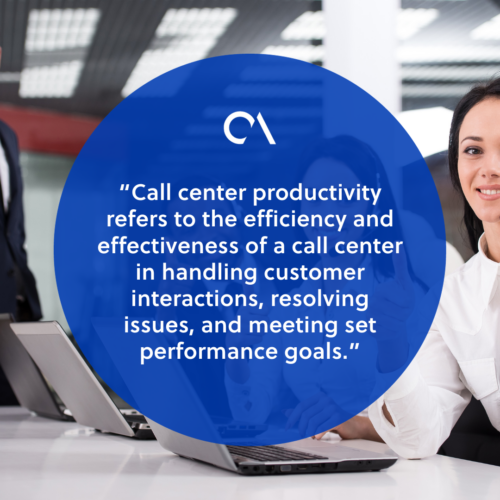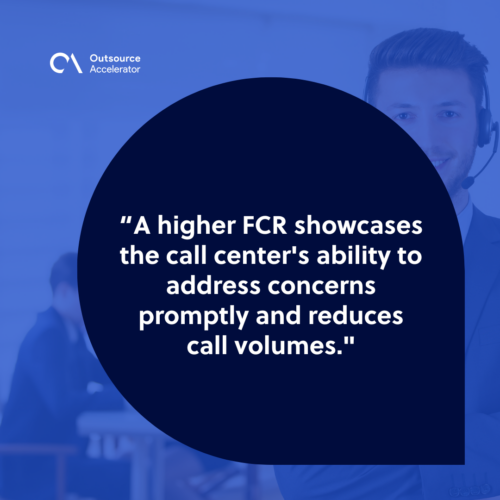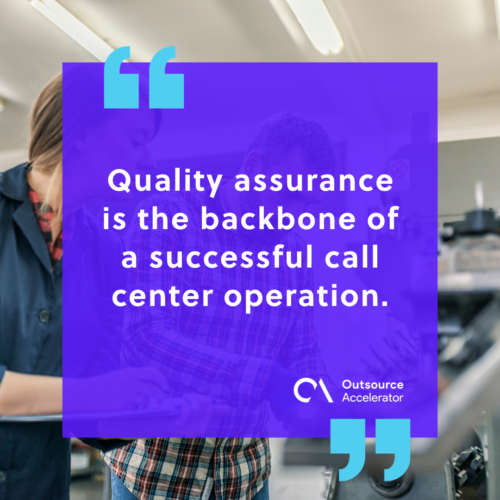How to measure call center productivity

Beyond delivering exceptional customer service, the number one goal of a call center is often to optimize operational efficiency while maintaining service quality through productivity.
Enhancing call center productivity holds heightened significance in business process outsourcing (BPO) industries. BPOs function on the premise of delivering outsourced services with superior quality, often handling diverse clients and industries.
Several adverse outcomes surface if agents within a call center aren’t productive. Longer wait times for customers may lead to dissatisfaction and higher employee turnover rates due to frustration from underperformance.
Moreover, failure to enhance productivity within a call center can result in contractual breaches, loss of clients, and, ultimately, reputational damage in a fiercely competitive market.
This article delves into the nuances of measuring, understanding, and maximizing call center productivity.
What is call center productivity?
Call center productivity refers to the efficiency and effectiveness of a call center in handling customer interactions, resolving issues, and meeting set performance goals.
It encompasses various factors, such as:
- Utilization of resources (such as agents, technology, and time)
- Quality of customer service delivered
- Achievement of key performance indicators (KPIs)
Call center productivity is not solely about the number of calls handled but also involves factors like the speed of issue resolution and customer satisfaction.

Why should you measure call center productivity?
Measuring call center productivity is essential as it provides crucial insights into the effectiveness of a call center’s performance. Productivity measurement allows businesses to identify strengths, weaknesses, and areas for improvement.
A call center with a productive workforce translates to reduced wait times, quicker issue resolution, and a higher likelihood of first-contact resolution.
Furthermore, the data gathered by measuring call center productivity is a foundation for setting realistic and achievable goals. It allows for establishing benchmarks and performance targets, motivating teams to strive for continuous improvement.
How to measure call center productivity
Measuring call center productivity involves a multifaceted approach beyond just assessing quantitative metrics.
It begins by comprehensively analyzing the various facets of call center operations, including agent performance, process efficiency, and overall customer experience.
In connection, evaluating agent performance entails monitoring key indicators like adherence to scripts, resolution rates, and customer satisfaction scores.
Assessing process efficiency involves:
- Monitoring workflows and technological infrastructure
- Identifying bottlenecks that impede smooth operations
Exploring the customer experience includes gathering feedback, conducting surveys, and analyzing interaction data to assess satisfaction and problem-resolution effectiveness.
This evaluation necessitates using advanced analytics tools and reporting mechanisms that combine data from various sources. This is to provide a holistic view of call center performance.
It also involves qualitative assessments, such as quality assurance checks and agent coaching sessions. This supplements quantitative data with insights into service quality and customer interactions.
Furthermore, integrating both quantitative metrics and qualitative assessments enables a comprehensive understanding of call center productivity. This facilitates informed decision-making and targeted strategies for continuous improvement.
Call center productivity metrics to consider
Several call center key performance indicators (KPIs) serve as benchmarks for assessing call center efficiency:
Average Handle Time (AHT)
Average Handle Time is a vital metric covering the efficiency of a call center’s operations.
Beyond merely measuring the duration of a call, this call center productivity metric includes various facets, including talk time, hold time, and post-call tasks.
While a lower AHT typically signals heightened efficiency, balancing it with service quality is a crucial qualification. Rushing through interactions to reduce AHT might compromise the depth and quality of customer assistance.
Therefore, the focus should be optimizing AHT without compromising the resolution quality or leaving customers feeling rushed or dissatisfied.
First Call Resolution (FCR)
First Call Resolution emerges as a critical indicator of a call center’s efficacy in problem-solving.
This call center productivity metric evaluates the percentage of issues resolved during the initial customer interaction. A higher FCR showcases the call center’s ability to address concerns promptly and reduces call volumes.
Achieving a high First Call Resolution demands a comprehensive understanding of customer needs, well-equipped agents, and robust systems.
Moreover, FCR directly impacts customer satisfaction by minimizing the need for repeated contact regarding the same issue. This enhances the overall experience and fosters a positive impression of the company.

Call Abandonment Rate (CAR)
Call Abandonment Rate sheds light on the percentage of callers who disconnect before connecting with an agent. High abandonment rates often signal underlying issues such as prolonged wait times or ineffective call routing.
High CAR can damage customer experience and retention as impatient callers might seek alternative solutions or services.
Addressing CAR involves the following actions to reduce wait times and ensure efficient call handling:
- Optimizing call routing mechanisms
- Managing staffing levels
- Leveraging technology
By mitigating CAR, call centers can enhance customer satisfaction, increase agent efficiency, and drive positive call center productivity.
Customer Satisfaction (CSAT)
The Customer Satisfaction (CSAT) metrics are a barometer of customer contentment post-interaction. Regularly gauging customer satisfaction allows call centers to:
- Grasp customer sentiment
- Identify pain points
- Uncover areas for improvement
It’s not solely a reflection of individual interactions but a collective evaluation of a call center’s overall performance.
Gathering and analyzing CSAT data aids in shaping training programs, refining service protocols, and addressing systemic issues to bolster customer experience.
A high CSAT signifies happy customers and serves as a testament to a call center’s commitment to delivering exceptional service.
Average Speed of Answer (ASA)
Average Speed of Answer mirrors a call center’s responsiveness by measuring a caller’s time waiting in the queue before connecting with an agent.
A low ASA requires effective call routing strategies, staffing adequacy, and technological support. However, maintaining an excessively low ASA without considering other factors can strain resources or compromise service quality.
Therefore, agents must balance these call center productivity metrics with staffing levels, agent capabilities, and workload distribution. It will ensure efficient call handling without neglecting the quality of service provided.
Service level
Service level denotes the percentage of calls answered within a specified timeframe. It is a crucial indicator of a call center’s ability to meet customer demand promptly.
It requires meticulous workforce management, efficient call routing, and adaptive strategies maintain service levels aligned with operational efficiency and customer satisfaction.
An excessively high service level might strain resources or impact other KPIs negatively.
Balancing service levels with other call center productivity metrics is critical for an optimized call center. While achieving a high service level is desirable, it must align with other performance metrics to avoid potential trade-offs.
Tips to improve call center productivity
Here are some strategies to enhance your call center productivity:
Support agents in their continuous development
Investing in training and development programs is vital for fostering a culture of continuous learning among call center agents.
These initiatives equip agents with updated skills and knowledge and instill confidence and motivation to handle diverse customer issues effectively.
Tailored training programs, workshops, and coaching sessions let agents stay abreast of evolving customer needs, new products or services, and effective communication techniques.
By nurturing agent development, organizations elevate the overall quality of customer interactions, leading to increased call center productivity.
Invest in advanced call center software and tools
Integrating cutting-edge technology within call centers, such as AI-driven analytics, chatbots, and CRM systems, revolutionizes operations by automating tasks.
For example, a platform like Hubstaff generates productivity insights to help you see how you can best optimize your team’s workflows. The company behind the tool understands that there isn’t a one-size-fits-all approach when it comes to remote work, detailing this in its recent Workstyle report.
AI-powered analytics offer deep insights into customer behavior and preferences, aiding personalized interactions.
Such tools enhance agent efficiency and increase call center productivity, resulting in quicker resolutions and a more personalized approach.
Implement effective call routing
Implementing intelligent call routing systems is instrumental in optimizing call center operations. It ensures that customers are directed to the right resource promptly.
By efficiently routing calls to the most qualified agents based on skillset, language proficiency, or issue complexity, organizations can:
- Reduce wait times
- Improve First Call Resolution
- Minimize the need for call transfers
This not only boosts customer satisfaction by reducing hold times but also enhances call center productivity.
Set realistic and achievable goals
Setting realistic and achievable goals in a call center involves a thoughtful approach that considers the specific context and capabilities of the team.
An example of a realistic goal could be to reduce Average Handle Time (AHT) by 10% over the next quarter while maintaining or improving customer satisfaction levels.
This goal is specific, measurable, achievable, relevant, and time-bound (SMART). It provides a clear target for agents to focus on while ensuring that customer service quality isn’t compromised.
However, achieving this goal would require call center optimization, agent training, or implementing new tools to streamline operations without rushing through customer interactions.
Meanwhile, an unrealistic expectation that doesn’t contribute to call center productivity could be setting a goal to reduce AHT by 50% within a month. Simply put, you implement this goal without even considering the impact on service quality.
Unrealistic goals often lead to undue pressure on agents, compromising the quality of customer service and potentially causing burnout among the team.
Prioritize quality assurance
Quality assurance is the backbone of a successful call center operation. Regularly monitoring and assessing interactions—whether through call evaluations or performance reviews—ensures service quality and consistency.
It’s not merely spotting mistakes but rather about identifying patterns, strengths, and areas for improvement. Providing actionable feedback based on these evaluations equips agents with specific guidance for enhancement.
Consistency in quality assurance creates a standard for excellence, instilling confidence in agents and boosting their capabilities. It also showcases the call center’s commitment to delivering exceptional service, ultimately contributing to higher call center productivity rates.
Focus on employee well-being
A call center’s performance is intricately tied to the well-being of its employees. Creating a supportive work environment through initiatives prioritizing work-life balance, mental health, and recognition programs is pivotal.
Employees who feel valued and supported are more engaged, motivated, and committed to their roles. Work-life balance initiatives, such as flexible scheduling or wellness programs, reduce burnout and increase job satisfaction.
Recognition programs acknowledge and appreciate agents’ efforts, boosting morale and fostering a positive workplace culture.
By investing in employee well-being, call centers enhance retention rates and witness improvements in call center productivity performance. Happier employees tend to deliver better customer service.
Maximize your call center productivity with this guide
Maximizing call center productivity isn’t merely about reaching arbitrary numerical targets. It’s about creating an environment where efficiency and quality converge to form a solid foundation for customer success.
But remember that the essence of call center productivity lies in a customer-centric approach.
While metrics and technology play crucial roles in optimizing operations, the following human elements remain the heartbeat of exceptional service:
- Empathy
- Understanding
- Genuine connection with customers
Customer service representatives who empathize with customers, actively listen, and go beyond scripted responses contribute significantly to long-term customer loyalty and satisfaction.








 Independent
Independent




